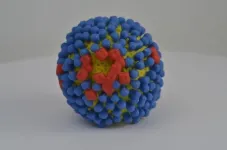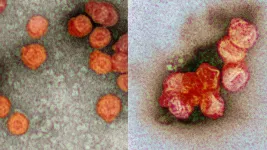(Press-News.org) Aging-US published "Sulforaphane promotes C. elegans longevity and healthspan via DAF- 16/DAF-2 insulin/IGF-1 signaling" which reported that the broccoli-derived isothiocyanate sulforaphane inhibits inflammation, oxidative stress and cancer, but its effect on healthspan and longevity are unclear.
The authors used the C. elegans nematode model and fed the wildtype and 9 mutant strains ±sulforaphane.
Sulforaphane increased the lifespan and promoted a health-related phenotype by increasing mobility, appetite and food intake and reducing lipofuscin accumulation.
Mechanistically, sulforaphane inhibited DAF-2-mediated insulin/insulin-like growth factor signaling and its downstream targets AGE-1, AKT-1/AKT-2. This was associated with increased nuclear translocation of the FOXO transcription factor homolog DAF-16. In turn, the target genes sod-3, mtl-1 and gst-4, known to enhance stress resistance and lifespan, were upregulated.
The results in this Aging-US research output, indicate that sulforaphane prolongs the lifespan and healthspan of C. elegans through insulin/IGF-1 signaling. They provide the basis for a nutritional sulforaphane-enriched strategy for the promotion of healthy aging and disease prevention.
Dr. Ingrid Herr from The University of Heidelberg said, "The risk of cancer, cardiovascular disease, and neurodegeneration rises dramatically later in life."
Pak choy, which is one of the most widely consumed Brassica vegetables in Asian countries, have been reported to enhance antioxidant activity in a cell-free system and exert anti-aging effects in the nematode Caenorhabditis elegans.
C. elegans is one of the most widely used models for aging research due to its short lifespan of approximately 4 weeks and highly conserved key aging-related signaling molecules .
Here, the authors asked whether sulforaphane may influence the lifespan and healthspan of C. elegans.
They found that sulforaphane significantly extends the lifespan of C. elegans and delays age-related phenotype changes.
The analysis of wild-type C. elegans and 9 mutant strains revealed that sulforaphane inhibited DAF-2 insulin/insulin receptor signaling and thereby increased DAF-16 nuclear translocation, resulting in the expression of the sod-3, mtl-1 and gst-4 target genes, which are known mediators of longevity in C. elegans.
The Herr Research Team concluded in their Aging-US Research Paper, "we are the first to report that sulforaphane prolongs the lifespan and increases the healthspan of C. elegans through the inhibition of DAF- 2/insulin/IGF-1 signaling and the activation of DAF- 16/FOXO nuclear transcription in C. elegans. Our study provides a promising hint regarding the suitability of sulforaphane as a new anti-aging drug. However, additional studies in invertebrates and mammalian model organisms are necessary to expand our findings."
INFORMATION:
Full Text - https://www.aging-us.com/article/202512/text
Correspondence to: Ingrid Herr email: i.herr@uni-heidelberg.de
Keywords: Caenorhabditis elegans, aging, sulforaphane, DAF-16 insulin
About Aging-US
Launched in 2009, Aging-US publishes papers of general interest and biological significance in all fields of aging research as well as topics beyond traditional gerontology, including, but not limited to, cellular and molecular biology, human age-related diseases, pathology in model organisms, cancer, signal transduction pathways (e.g., p53, sirtuins, and PI-3K/AKT/mTOR among others), and approaches to modulating these signaling pathways.
To learn more about Aging-US, please visit http://www.Aging-US.com or connect with @AgingJrnl
Aging-US is published by Impact Journals, LLC please visit http://www.ImpactJournals.com or connect with @ImpactJrnls
Media Contact
18009220957x105
MEDIA@IMPACTJOURNALS.COM
Amsterdam, NL, February 3, 2021 - Patients with Parkinson's disease (PD) and healthcare professionals caring for them have expressed concerns about the COVID-19 vaccine's efficacy and safety in the specific context of PD and its symptomatic treatment. In a END ...
WHAT:
An experimental single-dose, intranasal influenza vaccine was safe and produced a durable immune response when tested in a Phase 1 study published in the Journal of Clinical Investigation. The investigational vaccine, called Ad4-H5-VTN, is a recombinant, replicating adenovirus vaccine designed to spur antibodies to hemagglutinin, a protein found on the surface of influenza viruses that attaches to human cells.
The investigational vaccine was developed by Emergent Biosolutions Inc., (Gaithersburg, Maryland). It was administered intranasally (28 study participants), as an oral capsule (10 participants) and via a tonsillar swab (25 participants) to ...
BATON ROUGE, LOUISIANA - In patients with type 2 diabetes, big swings in blood sugar levels between doctors' visits are associated with an increased risk of heart disease.
The study, published in the journal Diabetes, Obesity & Metabolism, looked at more than 29,000 patients with type 2 diabetes over a two-year period. Patients who already had heart disease were excluded.
The American Diabetes Association recommends adults with diabetes maintain an A1c, the average blood sugar level over the past two to three months, of less than 7 percent to reduce complications from diabetes, such ...
A study published in the journal Applied Ergonomics compared the standardised processes set out for community pharmacists to follow when dispending medication to what happens in reality. A gap was revealed and researchers also looked at the reasons for this.
The research, "Mind the gap: Examining work-as-imagined and work-as-done when dispensing medication in the community pharmacy setting"*, was conducted by the National Institute for Health Research Greater Manchester Patient Safety Translational Research Centre (NIHR GM PSTRC). The Centre is a partnership between The University of Manchester and Salford Royal NHS Foundation Trust.
The research involved observing pharmacists and pharmacy staff as they conducted the task of dispensing, ...
Sneakers can be about style, history and even community. A new study reveals that for "Sneakerheads," sneakers are an important facet of their identities, particularly for African-American men who grew up in the 1970s and '80s coveting sneakers popularized by hip-hop stars and basketball legends.
In the journal Fashion and Textiles, researchers report new insights into the motivations, brand preferences and identity considerations of Sneakerheads. The findings were drawn from interviews with 12 men in the mid-Atlantic region of the United States, many whom are African-American, and ...
Researchers have developed a computerized adaptive screener to identify youth at risk for attempting suicide. The screener, called the computerized adaptive screen for suicidal youth (CASSY), consists of 11 questions on average and correctly identified 82.4% of youth who went on to attempt suicide in the three months following screening. The results suggest this screener could serve as an easy-to-use way for providers to detect youth suicide risk in emergency department settings. The findings, funded by the National Institute of Mental Health (NIMH), ...
Today, neuroscience and robotics are developing hand in hand. Mikhail Lebedev, Academic Supervisor at HSE University's Centre for Bioelectric Interfaces, spoke about how studying the brain inspires the development of robots.
Robots are interesting to neuroscience and neuroscience is interesting to robots - this is what the article 'Neuroengineering challenges of fusing robotics and neuroscience' was about in the journal Science Robotics. Such collaborative development contributes to progress in both fields, bringing us closer to developing more advanced android robots and a deeper understanding ...
Among the many avenues that viruses can use to infect humans, drinking water may pose only a tiny risk for spreading certain viruses like the novel coronavirus. However, in cases where there is unauthorized wastewater disposal or other events of inadvertent mixing of wastewater with water sources, the possibility of transmission through drinking water remains unknown.
Using a surrogate of the coronavirus that only infects bacteria, researchers at Texas A&M University have now presented strong evidence that existing water purification plants can easily reduce vast quantities of the virus thereby protecting our household water from such contagions. In particular, the researchers showed that the water purification step called coagulation could alone get rid of 99.999% of ...
The economic value of insect pollinators was $34 billion in the U.S. in 2012, much higher than previously thought, according to researchers at the University of Pittsburgh and Penn State University. The team also found that areas that are economically most reliant on insect pollinators are the same areas where pollinator habitat and forage quality are poor.
"Pollinators like bees play an extremely important role in agriculture," explained senior author Vikas Khanna, Wellington C. Carl Faculty Fellow and associate professor of civil and environmental engineering at Pitt's Swanson School of Engineering. "The insects that pollinate farmers' crops underpin our ecosystem biodiversity and function, ...
BOSTON - Although abnormal blood clotting has been identified as one of the primary causes of death from COVID-19, early treatment in an intensive care unit (ICU) with therapeutic anticoagulation (anti-clotting) for adults who are critically ill with COVID-19 does not appear to improve chances of survival, and could do more harm than good by increasing the risk for major bleeding, a multicenter research group cautions.
"In patients critically ill with COVID-19, therapeutic dose anticoagulation started early in the ICU stay was not associated with improved survival,"says Hanny Al-Samkari, MD, an investigator in the Division of Hematology/Oncology at Massachusetts General Hospital (MGH) and lead author ...



